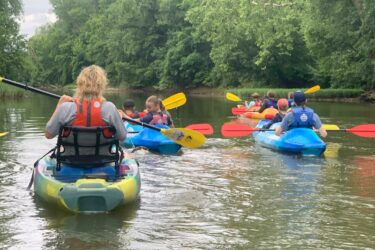
Eight-year old Elizabeth Stallings, a student at Oak View Elementary in the Williamson County school district and a former student of Terry Rogers’ second grade class, explained to her mother how her brain is wired.
“I knew something interesting was going on when Elizabeth came home from school excited about her ‘schema’ and how it helped her to remember,” says Christi, Elizabeth’s mom. Elizabeth’s difficulty recalling certain academic material is overcome through Quantum Learning strategies and by using her schema, which she says is located “way back behind my ear.â€
Christi says, “She is always excited to go to school, and she really developed confidence by being in Mrs. Rogers’ class.â€
“Quantum Learning is my passion and has changed the way I will teach forever,” says Rogers. She says her 18-year teaching career has never been the same since her husband, Stephen, brought her a newspaper article on Quantum Learning. A passion arose in her that has been burning ever since.
Quantum Learning, co-founded by Bobbi DePorter, president of the Quantum Learning Network, is a comprehensive learning and life skills program based on brain research. By using visual, auditory and kinesthetic learning strategies the program incorporates music, color and movement to aid in retention.
Denise Goodwin, principal at Oak View Elementary, agreed to send Rogers to a workshop to learn more about the program.
“I was blown away,” Rogers says. “The program is based on brain research that teaches children to retain information, keep them engaged and most of all have fun and build confidence while they are doing it. I became excited and motivated to try it.â€
Beginning with how children learn best – i.e., their learning style – Rogers created an enriched classroom environment. The classroom mood is enhanced by lamps, providing pleasant lighting and live plants that create a homey atmosphere. Rogers plays soothing yet energizing music and scents the room with lemon-citrus to keep students alert and prepared for the Quantum Learning strategies.
She uses Quantum Learning key phrases with her students like, “Everything Is On Purpose” and “Failure Leads To Success.” Each morning, students enter her classroom to the song “We Are Family” by Sister Sledge. Positive affirmations adorn the walls, and confidence-building mottos are recited each day such as:
“It’s OK to try and fail, and try and fail again, but it’s not OK to try and fail and fail to try again.â€
“Experience first, learning follows.â€
“This is a learning place, not a knowing place.â€
Also, instead of routine tasks to assess knowledge, tests are called “celebrations.â€
“It is important to create a comfortable, safe, positive and stimulating classroom environment for learning and taking risks,” Rogers said.
Rogers has used Quantum Learning for about three years and was chosen to be a Quantum Learning trainer for groups in her area as part of the Quantum Learning Network.
Many inspired educators in the area have received Quantum Learning training. Over the past five years, Quantum Learning training has been conducted in 25 counties in Tennessee for nearly 200 schools.
The Williamson County School District offers Quantum Learning workshops and recently offered a district-wide sponsored training seminar.
Even though many schools in Williamson County are now using the Quantum Learning methodologies, Oak View Elementary was one of the first schools to receive all five levels of the Quantum Learning teacher’s training and to make the decision as a school to adopt the Quantum Learning program as its school-wide philosophy.
Principal Goodwin says, “As a school, we embrace the whole philosophy of Quantum Learning, which has brought a culture and understanding of how we teach and why we teach. We love it.â€
Dan St. Romain, Quantum Learning educator, trainer and national presenter with the Quantum Learning Network, recently conducted training sessions for the Williamson County School District. “Quantum Learning has a strong life skills component that can be a powerful tool in parenting,” Romain says. “It teaches children to take ownership of the choices they make and how to ‘live above the line.’ It also teaches them to recognize whether their child is a visual, auditory or kinesthetic learner, which helps them meet the learning needs of their child,” he adds.
More about Quantum Learning
According to Bobbi DePorter, co-author of Quantum Learning: Unleashing the Genius In You (Dell; $14.95), Quantum Learning is based on brain research using theories and strategies such as the right/left brain theory; the triune brain theory; modality preference (visual, auditory, kinesthetic); theory of multiple intelligences; holistic education; experiential learning; metaphoric learning; and simulation gaming.
It’s OK to be “Dense:” 3 Big Brain Ideas
The next time someone calls your child dense, tell him to say, “Why thank you, my neurons are firing and wiring.” Afterall, Quantum Learning is based on three “Big Brain Ideas.â€
- There Is No Comprehension Without Picturing
- Students Make Meaning by Connecting Existing Schema
- Neurons That Fire Together Wire Together
In principle, if a child’s schema (prior knowledge) is built by making connections such as by picturing, experiencing and reviewing concepts, retention will be strong.
Visual, Auditory and Kinesthetic Learning
To understand Quantum Learning at work, building connections, say with a story, is done by using a “narrative chain.” The story might be made silly, highlighting key words and visual images that relate to the concept being taught. After review and “callbacks” (repeating what the teacher says out loud), students retain the key words and concepts because they remember and can recite the entertaining story. The story is used as a vehicle for building connections.
Further, as a demonstration, Rogers shows the parents of children in her classroom how to help their children memorize spelling words. First, parents fold a piece of paper into four sections, divide the word into four parts and write each part of the word in each quadrant using different colored markers. Then, they hold the word slightly above their heads looking up, which accesses the visual cortex. Last, they close their eyes and paint each section of the word in the air.
Rogers believes that Quantum Learning is a wonderful tool for teachers and parents in any discipline or subject. It is the “how to” in presenting material to children. “After the first training session, you leave with a new technique that you can implement the next day,” Rogers said.
“I look forward to each day so much more. As a teacher, I am excited, and that’s contagious.â€
Kerri Bartlett is a freelance writer.
To learn more about Quantum Learning, please visit the Quantum Learning Web site at www.qln.com.
To organize a Quantum Learning training session for your organization, contact Carol Fetzer, Senior Consultant of Quantum Learning Programs in Tennessee at 800-285-3276 or by e-mail at cfetzer@qln.com.




